panel BUICK LUCERNE 2009 Workshop Manual
[x] Cancel search | Manufacturer: BUICK, Model Year: 2009, Model line: LUCERNE, Model: BUICK LUCERNE 2009Pages: 436
Page 311 of 436
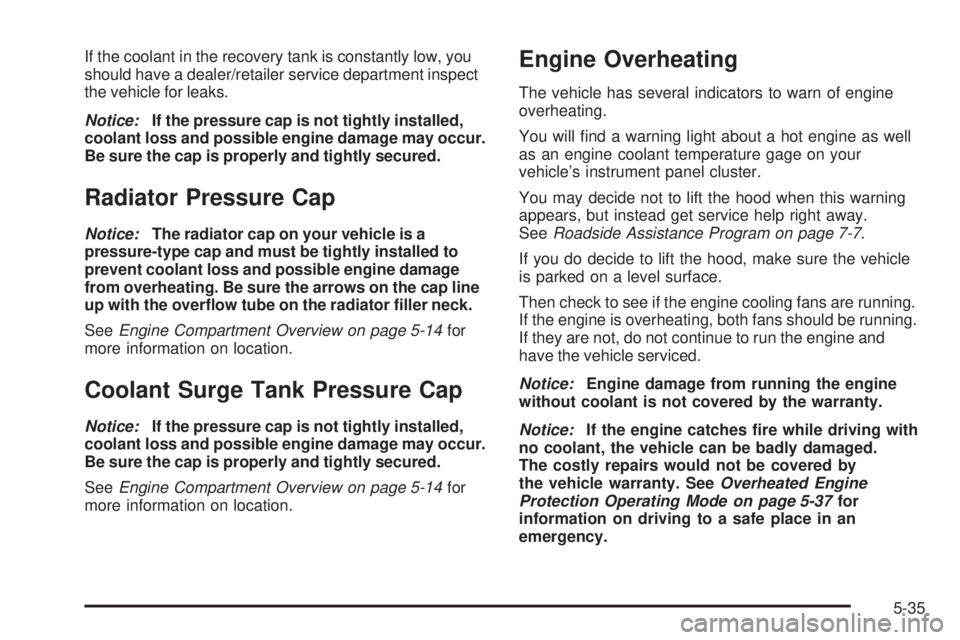
If the coolant in the recovery tank is constantly low, you
should have a dealer/retailer service department inspect
the vehicle for leaks.
Notice:If the pressure cap is not tightly installed,
coolant loss and possible engine damage may occur.
Be sure the cap is properly and tightly secured.
Radiator Pressure Cap
Notice:The radiator cap on your vehicle is a
pressure-type cap and must be tightly installed to
prevent coolant loss and possible engine damage
from overheating. Be sure the arrows on the cap line
up with the over�ow tube on the radiator �ller neck.
SeeEngine Compartment Overview on page 5-14for
more information on location.
Coolant Surge Tank Pressure Cap
Notice:If the pressure cap is not tightly installed,
coolant loss and possible engine damage may occur.
Be sure the cap is properly and tightly secured.
SeeEngine Compartment Overview on page 5-14for
more information on location.
Engine Overheating
The vehicle has several indicators to warn of engine
overheating.
You will �nd a warning light about a hot engine as well
as an engine coolant temperature gage on your
vehicle’s instrument panel cluster.
You may decide not to lift the hood when this warning
appears, but instead get service help right away.
SeeRoadside Assistance Program on page 7-7.
If you do decide to lift the hood, make sure the vehicle
is parked on a level surface.
Then check to see if the engine cooling fans are running.
If the engine is overheating, both fans should be running.
If they are not, do not continue to run the engine and
have the vehicle serviced.
Notice:Engine damage from running the engine
without coolant is not covered by the warranty.
Notice:If the engine catches �re while driving with
no coolant, the vehicle can be badly damaged.
The costly repairs would not be covered by
the vehicle warranty. SeeOverheated Engine
Protection Operating Mode on page 5-37for
information on driving to a safe place in an
emergency.
5-35
Page 345 of 436

Tire Pressure Monitor Operation
This vehicle may have a Tire Pressure Monitor System
(TPMS). The TPMS is designed to warn the driver when
a low tire pressure condition exists. TPMS sensors are
mounted onto each tire and wheel assembly, excluding
the spare tire and wheel assembly. The TPMS sensors
monitor the air pressure in the vehicle’s tires and
transmits the tire pressure readings to a receiver
located in the vehicle.
When a low tire pressure
condition is detected, the
TPMS illuminates the
low tire pressure warning
light located on the
instrument panel cluster.
At the same time a message to check the pressure in a
speci�c tire appears on the Driver Information Center
(DIC) display. The low tire pressure warning light and the
DIC warning message come on at each ignition cycle
until the tires are in�ated to the correct in�ation pressure.
Using the DIC, tire pressure levels can be viewed by thedriver. For additional information and details about the
DIC operation and displays seeDIC Operation and
Displays on page 3-49andDIC Warnings and Messages
on page 3-56.
The low tire pressure warning light may come on in
cool weather when the vehicle is �rst started, and then
turn off as you start to drive. This could be an early
indicator that the air pressure in the tire(s) are getting
low and need to be in�ated to the proper pressure.
A Tire and Loading Information label, attached to
your vehicle, shows the size of your vehicle’s original
equipment tires and the correct in�ation pressure for
your vehicle’s tires when they are cold. SeeLoading the
Vehicle on page 4-18, for an example of the Tire and
Loading Information label and its location on your vehicle.
Also seeInflation - Tire Pressure on page 5-66.
Your vehicle’s TPMS can warn you about a low tire
pressure condition but it does not replace normal
tire maintenance. SeeTire Inspection and Rotation
on page 5-72andTires on page 5-59.
Notice:Liquid tire sealants could damage the Tire
Pressure Monitor System (TPMS) sensors. Sensor
damage caused by using a tire sealant is not
covered by your warranty. Do not use liquid tire
sealants.
5-69
Page 371 of 436

Instrument Panel, Vinyl, and Other
Plastic Surfaces
A soft cloth dampened with water may be used to
remove dust. If a more thorough cleaning is necessary,
a clean soft cloth dampened with a mild soap solution can
be used to gently remove dust and dirt. Never use spot
lifters or removers on plastic surfaces. Many commercial
cleaners and coatings that are sold to preserve and
protect soft plastic surfaces may permanently change
the appearance and feel of the interior and are not
recommended. Do not use silicone or wax-based
products, or those containing organic solvents to
clean the vehicle’s interior because they can alter the
appearance by increasing the gloss in a non-uniform
manner.
Some commercial products may increase gloss on the
instrument panel. The increase in gloss may cause
annoying re�ections in the windshield and even make
it difficult to see through the windshield under certain
conditions.
Care of Safety Belts
Keep belts clean and dry.
{CAUTION:
Do not bleach or dye safety belts. It may severely
weaken them. In a crash, they might not be able
to provide adequate protection. Clean safety belts
only with mild soap and lukewarm water.
Weatherstrips
Silicone grease on weatherstrips will make them last
longer, seal better, and not stick or squeak. Apply
silicone grease with a clean cloth. During very cold,
damp weather frequent application may be required.
SeeRecommended Fluids and Lubricants on page 6-12.
5-95
Page 376 of 436

Vehicle Identi�cation
Vehicle Identi�cation Number (VIN)
This is the legal identi�er for your vehicle. It appears on
a plate in the front corner of the instrument panel, on
the driver side. It can be seen through the windshield
from outside the vehicle. The VIN also appears on
the Vehicle Certi�cation and Service Parts labels and
the certi�cates of title and registration.
Engine Identi�cation
The eighth character in the VIN is the engine code. This
code helps identify the vehicle’s engine, speci�cations,
and replacement parts. See “Engine Speci�cations”
underCapacities and Specifications on page 5-109for
your vehicle’s engine code.
Service Parts Identi�cation Label
This label is on the spare tire cover. It is very helpful if
you ever need to order parts. The label has the
following information:
Vehicle Identi�cation Number (VIN)
Model designation
Paint information
Production options and special equipment
Do not remove this label from the vehicle.
Electrical System
Add-On Electrical Equipment
Notice:Do not add anything electrical to the vehicle
unless you check with your dealer/retailer �rst. Some
electrical equipment can damage the vehicle and the
damage would not be covered by the vehicle’s
warranty. Some add-on electrical equipment can
keep other components from working as they should.
Add-on equipment can drain the vehicle battery, even if
the vehicle is not operating.
The vehicle has an airbag system. Before attempting to
add anything electrical to the vehicle, seeServicing
Your Airbag-Equipped Vehicle on page 1-72.
5-100
Page 379 of 436
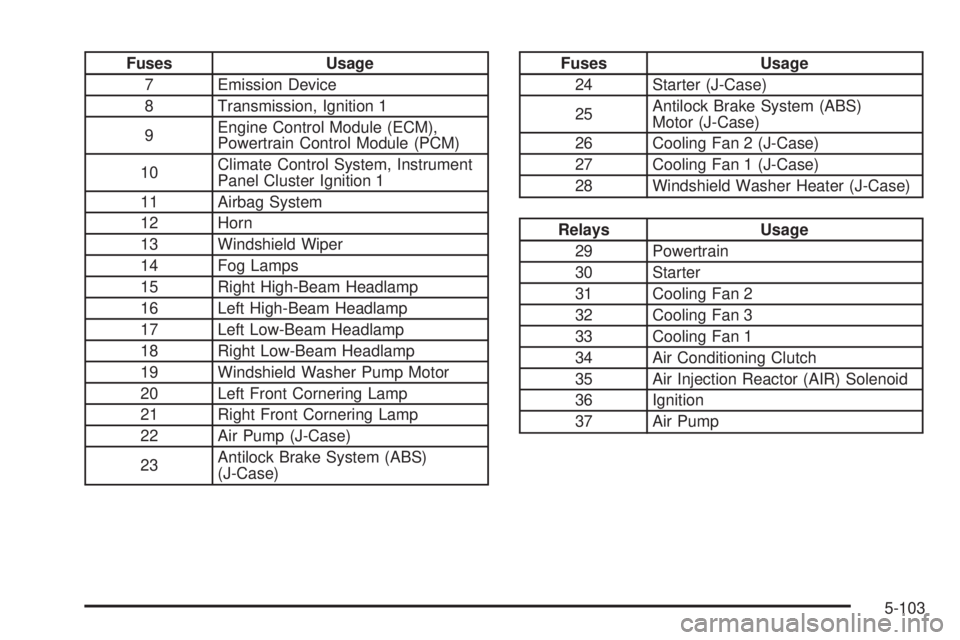
Fuses Usage
7 Emission Device
8 Transmission, Ignition 1
9Engine Control Module (ECM),
Powertrain Control Module (PCM)
10Climate Control System, Instrument
Panel Cluster Ignition 1
11 Airbag System
12 Horn
13 Windshield Wiper
14 Fog Lamps
15 Right High-Beam Headlamp
16 Left High-Beam Headlamp
17 Left Low-Beam Headlamp
18 Right Low-Beam Headlamp
19 Windshield Washer Pump Motor
20 Left Front Cornering Lamp
21 Right Front Cornering Lamp
22 Air Pump (J-Case)
23Antilock Brake System (ABS)
(J-Case)Fuses Usage
24 Starter (J-Case)
25Antilock Brake System (ABS)
Motor (J-Case)
26 Cooling Fan 2 (J-Case)
27 Cooling Fan 1 (J-Case)
28 Windshield Washer Heater (J-Case)
Relays Usage
29 Powertrain
30 Starter
31 Cooling Fan 2
32 Cooling Fan 3
33 Cooling Fan 1
34 Air Conditioning Clutch
35 Air Injection Reactor (AIR) Solenoid
36 Ignition
37 Air Pump
5-103
Page 406 of 436
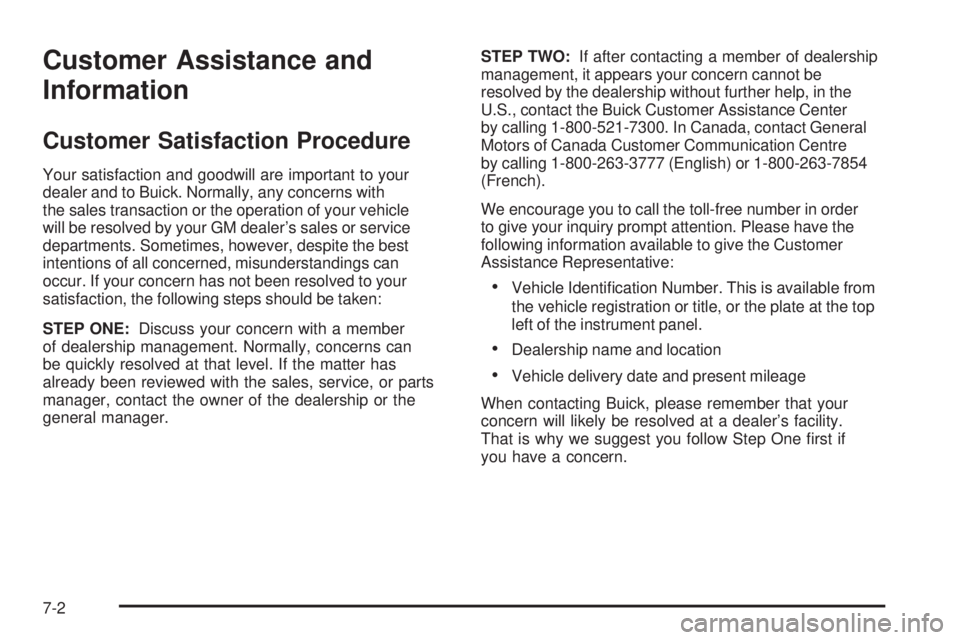
Customer Assistance and
Information
Customer Satisfaction Procedure
Your satisfaction and goodwill are important to your
dealer and to Buick. Normally, any concerns with
the sales transaction or the operation of your vehicle
will be resolved by your GM dealer’s sales or service
departments. Sometimes, however, despite the best
intentions of all concerned, misunderstandings can
occur. If your concern has not been resolved to your
satisfaction, the following steps should be taken:
STEP ONE:Discuss your concern with a member
of dealership management. Normally, concerns can
be quickly resolved at that level. If the matter has
already been reviewed with the sales, service, or parts
manager, contact the owner of the dealership or the
general manager.STEP TWO:If after contacting a member of dealership
management, it appears your concern cannot be
resolved by the dealership without further help, in the
U.S., contact the Buick Customer Assistance Center
by calling 1-800-521-7300. In Canada, contact General
Motors of Canada Customer Communication Centre
by calling 1-800-263-3777 (English) or 1-800-263-7854
(French).
We encourage you to call the toll-free number in order
to give your inquiry prompt attention. Please have the
following information available to give the Customer
Assistance Representative:
Vehicle Identi�cation Number. This is available from
the vehicle registration or title, or the plate at the top
left of the instrument panel.
Dealership name and location
Vehicle delivery date and present mileage
When contacting Buick, please remember that your
concern will likely be resolved at a dealer’s facility.
That is why we suggest you follow Step One �rst if
you have a concern.
7-2
Page 423 of 436
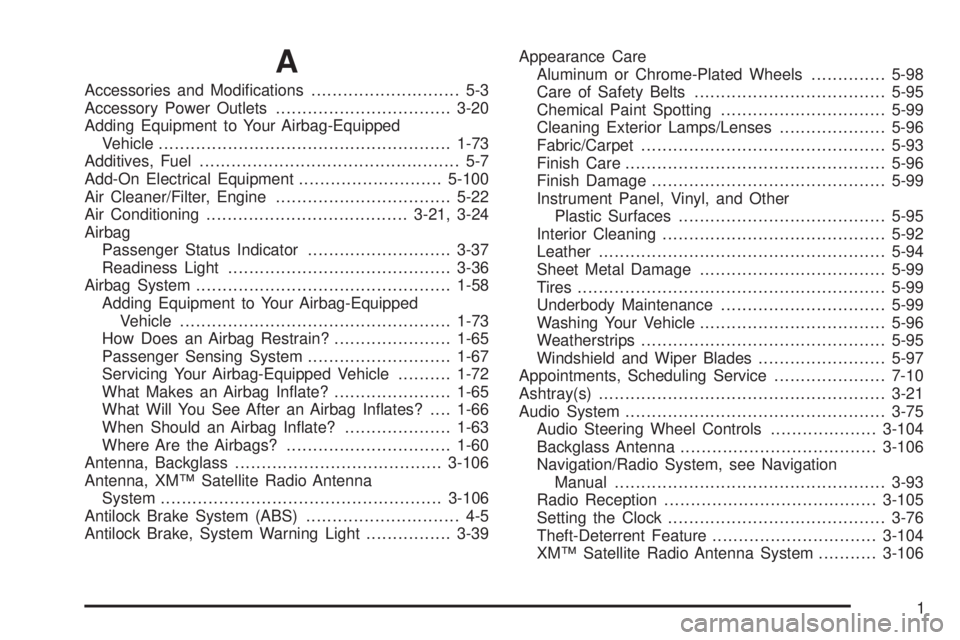
A
Accessories and Modi�cations............................ 5-3
Accessory Power Outlets.................................3-20
Adding Equipment to Your Airbag-Equipped
Vehicle.......................................................1-73
Additives, Fuel................................................. 5-7
Add-On Electrical Equipment...........................5-100
Air Cleaner/Filter, Engine.................................5-22
Air Conditioning......................................3-21, 3-24
Airbag
Passenger Status Indicator...........................3-37
Readiness Light..........................................3-36
Airbag System................................................1-58
Adding Equipment to Your Airbag-Equipped
Vehicle...................................................1-73
How Does an Airbag Restrain?......................1-65
Passenger Sensing System...........................1-67
Servicing Your Airbag-Equipped Vehicle..........1-72
What Makes an Airbag In�ate?......................1-65
What Will You See After an Airbag In�ates?....1-66
When Should an Airbag In�ate?....................1-63
Where Are the Airbags?...............................1-60
Antenna, Backglass.......................................3-106
Antenna, XM™ Satellite Radio Antenna
System.....................................................3-106
Antilock Brake System (ABS)............................. 4-5
Antilock Brake, System Warning Light................3-39Appearance Care
Aluminum or Chrome-Plated Wheels..............5-98
Care of Safety Belts....................................5-95
Chemical Paint Spotting...............................5-99
Cleaning Exterior Lamps/Lenses....................5-96
Fabric/Carpet..............................................5-93
Finish Care.................................................5-96
Finish Damage............................................5-99
Instrument Panel, Vinyl, and Other
Plastic Surfaces.......................................5-95
Interior Cleaning..........................................5-92
Leather......................................................5-94
Sheet Metal Damage...................................
5-99
Tires..........................................................5-99
Underbody Maintenance...............................5-99
Washing Your Vehicle...................................5-96
Weatherstrips..............................................5-95
Windshield and Wiper Blades........................5-97
Appointments, Scheduling Service.....................7-10
Ashtray(s)......................................................3-21
Audio System.................................................3-75
Audio Steering Wheel Controls....................3-104
Backglass Antenna.....................................3-106
Navigation/Radio System, see Navigation
Manual...................................................3-93
Radio Reception........................................3-105
Setting the Clock.........................................3-76
Theft-Deterrent Feature...............................3-104
XM™ Satellite Radio Antenna System...........3-106
1
Page 425 of 436

Checking Things Under the Hood......................5-12
Chemical Paint Spotting...................................5-99
Child Restraints
Child Restraint Systems...............................1-41
Infants and Young Children...........................1-38
Lower Anchors and Tethers for Children..........1-45
Older Children.............................................1-35
Securing a Child Restraint in a
Rear Seat Position...................................1-51
Securing a Child Restraint in the
Center Front Seat Position........................1-54
Securing a Child Restraint in the
Right Front Seat Position..........................1-54
Where to Put the Restraint...........................1-44
Cleaning
Aluminum or Chrome-Plated Wheels..............5-98
Exterior Lamps/Lenses.................................5-96
Fabric/Carpet..............................................5-93
Finish Care.................................................5-96
Instrument Panel, Vinyl, and Other Plastic
Surfaces.................................................5-95
Interior.......................................................5-92
Leather......................................................5-94
Tires..........................................................5-99
Underbody Maintenance...............................5-99
Washing Your Vehicle...................................5-96
Weatherstrips..............................................5-95
Windshield and Wiper Blades........................5-97Climate Control System...................................3-21
Air Filter, Passenger Compartment.................3-30
Dual Automatic............................................3-24
Outlet Adjustment........................................3-30
Clock, Setting.................................................3-76
Collision Damage Repair..................................7-12
Compact Spare Tire........................................5-91
Compass.......................................1-12, 2-34, 3-54
Content Theft-Deterrent....................................2-17
Control of a Vehicle.......................................... 4-3
Convenience Net............................................2-57
Coolant
Engine...............................................5-28, 5-32
Engine Temperature Gage............................3-42
Engine Temperature Warning Light.................3-42
Surge Tank Pressure Cap.............................5-35
Cooled Seats................................................... 1-7
Cooling System..............................................5-26
Cornering Lamps............................................3-17
Courtesy Lamps.............................................3-18
Cruise Control................................................3-12
Cruise Control Light........................................3-47
Cupholders....................................................2-57
Customer Assistance Information
Courtesy Transportation................................7-10
Customer Assistance for
Text Telephone (TTY) Users........................ 7-6
Customer Assistance Offices........................... 7-6
3
Page 428 of 436
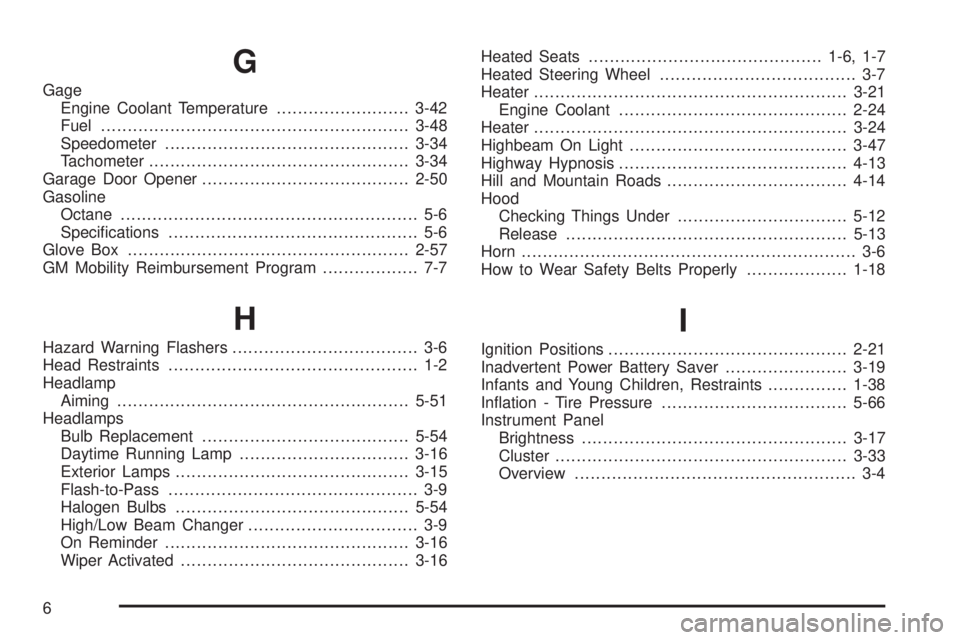
G
Gage
Engine Coolant Temperature.........................3-42
Fuel..........................................................3-48
Speedometer..............................................3-34
Tachometer.................................................3-34
Garage Door Opener.......................................2-50
Gasoline
Octane........................................................ 5-6
Speci�cations............................................... 5-6
Glove Box.....................................................2-57
GM Mobility Reimbursement Program.................. 7-7
H
Hazard Warning Flashers................................... 3-6
Head Restraints............................................... 1-2
Headlamp
Aiming .......................................................5-51
Headlamps
Bulb Replacement.......................................5-54
Daytime Running Lamp................................3-16
Exterior Lamps............................................3-15
Flash-to-Pass............................................... 3-9
Halogen Bulbs............................................5-54
High/Low Beam Changer................................ 3-9
On Reminder..............................................3-16
Wiper Activated...........................................3-16Heated Seats............................................1-6, 1-7
Heated Steering Wheel..................................... 3-7
Heater...........................................................3-21
Engine Coolant...........................................2-24
Heater...........................................................3-24
Highbeam On Light.........................................3-47
Highway Hypnosis...........................................4-13
Hill and Mountain Roads..................................4-14
Hood
Checking Things Under................................5-12
Release.....................................................5-13
Horn ............................................................... 3-6
How to Wear Safety Belts Properly...................1-18
I
Ignition Positions.............................................2-21
Inadvertent Power Battery Saver.......................3-19
Infants and Young Children, Restraints...............1-38
In�ation - Tire Pressure...................................5-66
Instrument Panel
Brightness..................................................3-17
Cluster.......................................................3-33
Overview..................................................... 3-4
6